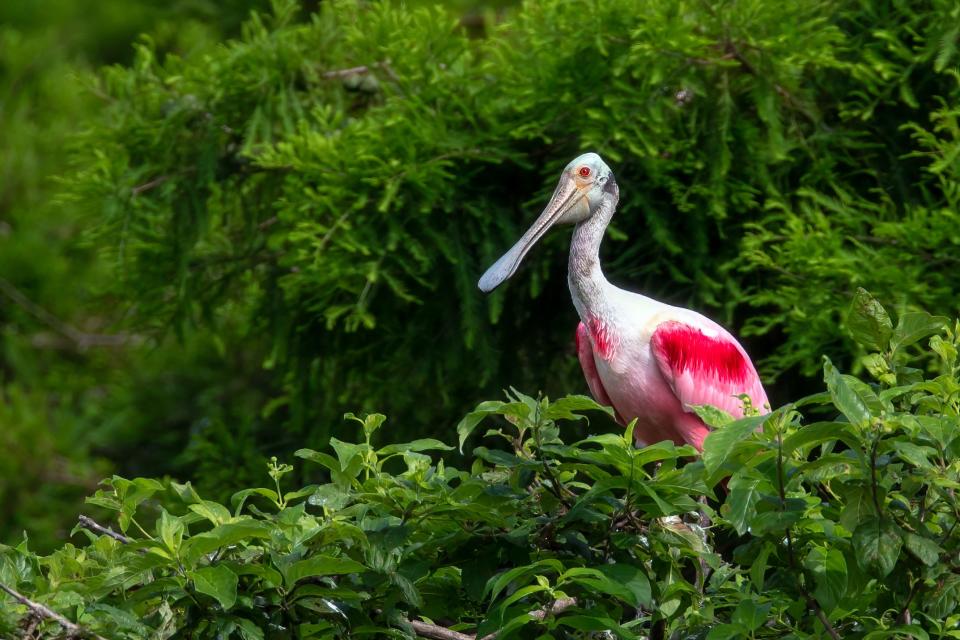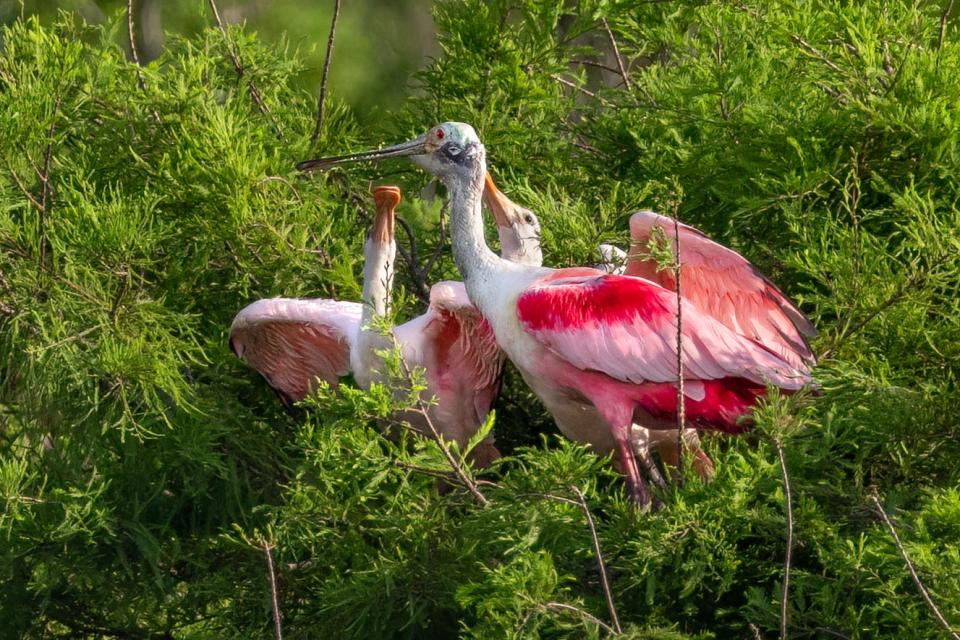Roseate spoonbills feeling the effects of rising seas and warming climate
Photographer Jami Linder’s father came home from the woods in early 2020 with a tale she could hardly believe. He'd met a man who invited her to come take pictures of the big, pink birds living in a remote swamp on his land near the Mississippi River.
Linder had tramped the woods and wilds in the southeastern corner of Arkansas with her dad all of her life and had never seen a pink bird. She knew they lived along marshy coastlines, but the closest was more than 200 miles to the south.
Successful conservation programs, combined with rising sea levels and warming temperatures, are shaking things up however, making such unlikely events more possible.
Linder soon packed up her Canon R5 and drove the 20 miles from her home to near Montrose to meet the property owner. She followed him down a long dirt road and through a gate to a cypress swamp, bright with spring green and alive with a breathtaking array of colorful wading birds. Herons. Egrets. Ibis. And sure enough, brilliant pink roseate spoonbills.
“I had never seen anything like that in real life,” Linder said. “It’s like you moved the Everglades into south Arkansas. Seriously, it’s crazy.”
Awestruck, she began snapping photos. One of those would prove groundbreaking.
Similar sightings continue to surprise and delight wildlife watchers across the country. These unique birds – with dark pink feathers, red eyes and spoon-shaped bills - have been seen occasionally in at least 34 states and three Canadian provinces during summers over the past 20 years.
They seemingly could turn up anywhere they find a pool of water suitable for swishing those broad bills back and forth for minnows and crustaceans.
Spoonbill expert Jerry Lorenz, state director of research for Audubon Florida, attributes this remarkable expansion of the birds’ range to three things: They’re recovering after being nearly wiped out more than a century ago; they’re being pushed out of their shallow coastal water habitats by rising sea levels; and they're finding warmer temperatures to the north.

Other wading birds also are finding new foraging and nesting locations, Lorenz said.
The birds are yet another example that climate change isn't something coming in the future, said Julie Wraithmell, Audubon Florida president. "It's here now, and we need to sit up and take notice."
While the birds may be flourishing as they are forced into newer, nonnative habitats, Wraithmell said, "whether these places are going to serve them well long term remains to be seen."
MAPLE SAP: Climate change means uncertain future for Northeast maple trees, syrup season
A century of recovery
In the early 20th century, some estimates put the population of roseate spoonbills at fewer than 30 pairs in South Florida.
They were one of many species of wading birds plundered by 19th-century plume hunters who slaughtered many thousands to sell feathers for hats. Entire birds were stuffed and perched on hats. Full spoonbill wings were used for ladies' fans. At one point, feathers were worth more than gold, an ounce valued at $80.
By 1913, bird conservationists convinced Congress to pass the Migratory Bird Act, bringing an end to the feather trade in the U.S.
Eventually, roseate spoonbills began to rebound in Florida and returned to traditional nesting grounds in Texas and Louisiana. By the 1990s, spoonbills had reclaimed nesting habitat on Florida’s east and west coasts. By the early 2000s, the birds began to nest even farther north on the peninsula.

Georgia officials watched the spoonbills closely for years, said Tim Keyes, coastal bird biologist for the state’s Department of Natural Resources. Adult birds had been spotted in breeding plumage – necks, heads and throats tinged with yellow gold feathers – and even carrying sticks that could have been nesting material, but no one had seen a nest.
In 2011, they confirmed a nest just across the Florida state line in St. Marys, Georgia, and the spoonbills have nested there every year since, Keyes said. This year, the spot included five nesting pairs.
In 2020, South Carolina also documented a nest, on private property near Charleston.
“All of this is a response to the warmer winters,” Lorenz said.
STUDY: Climate change pushing animals to migrate, increasing risks of new pandemics
The nesting range expansion is all the more remarkable because most spoonbills return to the area where they hatched to begin their own nesting, he said. According to his data, only 5%-10% of juvenile spoonbills build nests in other locations.
The farther the breeding colonies move north, the farther afield young spoonbills venture when leaving the nest, like the bird that turned up at Staten Island in 1992.
In August 2018, spoonbills were seen for the first time in Minnesota and Maine. Last summer a spoonbill was seen in Michigan. Today they’ve been reported to eBird, a popular bird-watching app, as far north as Quebec and Nova Scotia and from Maine to California.
Spoonbill salvation
The first spoonbill reported in Arkansas was seen in 1959. Gradually sightings became more frequent as the birds traveled north to areas along the Mississippi River, part of "a coastal surge of species" coming into the state, said Renn Tumlison, a vertebrate ecologist at Henderson State University. In September 2005, 128 spoonbills were counted near the river a little north of the swamp near Montrose where Linder snapped photos. But Tumlison said no one had ever documented a nest.
So when Linder posted her first spoonbill photo on an Arkansas wildlife Facebook group, she received a swift reply from a state biologist. “Are they breeding?”
Laughing, Linder said she replied: "I don't know, but everything else there is." Then she studied her photos of the rookery, finally finding one where a spoonbill on the periphery of the shot appeared to be sitting on a nest.
The photo proved to be the first evidence of a spoonbill nest in Arkansas. It’s the kind of evidence folks trying to prove that ivory-billed woodpeckers may still exist would give anything to have. Federal officials have proposed labeling the woodpecker, last seen in Arkansas, as extinct.
Hoping to document the spoonbill chicks, Linder kept snapping photos in the rookery for weeks. The COVID-19 pandemic was sweeping the nation. Staff at the Louisiana hospital where she works as a nurse weren't entirely sure what to make of the new virus that exploded there after Mardi Gras in 2020, she said. “They told us to stay away from people, so I did.”
“I stayed in the woods with a camera,” she said. “That was my salvation, that was my sanity through the early months of COVID.”
She not only captured photos of the spoonbill chicks, but she also documented the first Arkansas nest of a white-faced ibis, one of the other wading birds on the move.
While the spoonbills were expanding their range and finding new nesting grounds elsewhere, their numbers began to plummet among their traditional mangroves in Florida Bay.
Lorenz was initially stumped, but over time answers emerged.
“They’re leaving the coasts because of sea level rise,” he said. For example, a tide gauge at Key West shows the sea level has risen 9 inches since 1900, including 4 inches just since 2000.
“They require low water to forage and it’s not happening on the coast anymore,” he said. “The water levels are too high. Those birds’ legs are only so long. The bill is only so long. If the water level has gone up 6 inches and their bill is only 6-9 inches, that water’s too deep.”
The spoonbills will never return to the locations and numbers seen in the days before the plume hunters, he said. “They can’t, because sea level rise is changing all the habitat.”
The birds are moving higher up into the interior of the Everglades, where they have not been documented before. Lorenz said protection of that habitat is another example of why it's important to continue restoring historic water flow to the Everglades, disrupted by more than a century of diversion, development and flood control projects. It doesn’t surprise him that spoonbills have been able to adapt and respond to changes.
“They’ve been around since dinosaur times. They’re ancient,” he said. “They’ve seen glacial periods, rising and falling oceans. ... They’re not new to this game.
“And they are lots smarter than we are. They’re leaving the coasts.”
Dinah Voyles Pulver covers climate and environmental issues for USA TODAY. She can be reached at dpulver@gannett.com or at @dinahvp on Twitter.
This article originally appeared on USA TODAY: Climate change and rising sea level prompt roseate spoonbill migration
